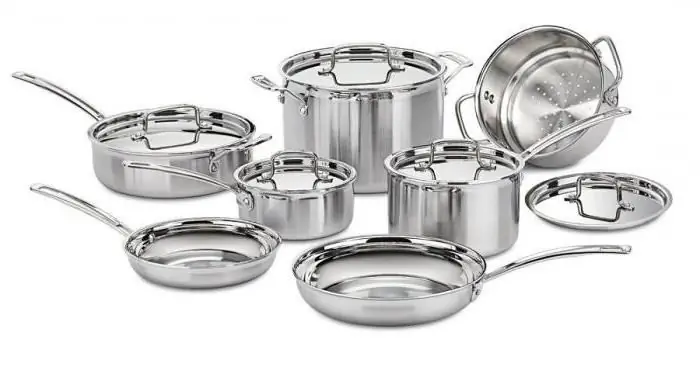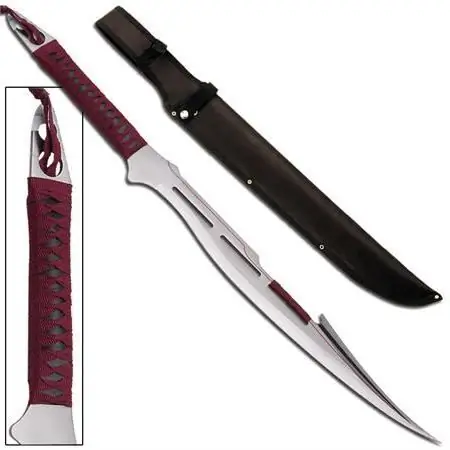2026 Author: Howard Calhoun | [email protected]. Last modified: 2025-01-24 13:10:26
In January 1915, the New York Times published an article about a new kind of steel. The manufacturer claimed that it does not darken, does not rust, and is perfect for making dishes and cutlery. This is how stainless steel and products made from it appeared in the world. The culprit of the properties of steel is ordinary chromium. In sufficient quantity, it ensures the presence of a special film on the surface of the alloy. The film can even self-heal from minor scratches and protect food and our taste buds from contact with metal.
Production of stainless steel products begins with casting iron
In a smelter, they first make ordinary steel that has carbon in it. It gives strength to iron. Further, miraculous metamorphoses take place with the material - it is sent to special furnaces and additives are added that determine the properties of stainless steel. In addition to chromium, it includes: nickel, titanium, molybdenumand other metals. The amount and type of additives will depend on the steel grade being produced.

Stainless steel is divided into several types:
- Chrome. It contains carbon and chromium in various percentages.
- Chrome-nickel. Consists of chromium and nickel with additions of copper, molybdenum, silicon.
- Chrome-manganese-nickel. In addition to chromium and nickel, manganese is added.
After smelting, the steel is put into molds. There it is rolled out and twisted into rolls, cut into sheets. Or they cast stainless steel products and containers from blanks.
Watch a video on how stainless steel is recycled.

What is stainless steel made of?
At present, it is difficult to imagine any production without this material. The scope of stainless steel products is so wide. So where is it used?
- Engineering and automotive industry.
- Chemical industry. Stainless steel is resistant to acids, so containers are made from it in factories.
- Aviation.
- Food industry.

- Interior and design.
- Medicine is a special kind of steel (surgical steel).
- Power industry.
- Production of stainless steel utensils.
Is this cookware safe?
Stainless steel made without violating technology is considered the most acceptable. The film on the surface repels bacteria, preventing them from accumulating. Dishes are easy to clean. Stainless steel is characterized by the peculiarity of not interacting with acids, which are abundant in food products. Therefore, dishes from it are safe. It can both cook and store food, sauces and marinades.

There are options to use enamel or aluminum cookware. But we all know for a long time that foods containing acids cannot be cooked in an aluminum pan. Otherwise, iron oxidizes, releasing harmful substances. Enamel is safer, but has its downsides.
Note that when buying stainless steel kitchen utensils, you should focus on the price. Too cheap products are better not to take. Let's see why? The fact is that dishes made of high-quality steel are expensive, and manufacturers are trying to cheat so that people with a wallet of any thickness can buy the product.
True, the cheaper the stainless steel pan, the lighter and more unreliable it will be. Manufacturers make the walls and bottom thinner, equip such products with cheap plastic handles. There is also a specific swindle, when the type of steel does not correspond to that stated on the marking. Then you can put an end to the safety of dishes.
How to choose the right stainless steel pot?
There are several characteristics to look out for. If you make the right choice, you can find dishes with the best value for money.
The most expensive are pans with a minimum nickel content or its complete absence. There is a theory that compounds of this metal are harmful and capable ofcause allergies. On such dishes there will be a mark indicating that there is no nickel in the composition. Note that there are no serious studies on this topic. So, there is a possibility that this is just another marketing ploy by manufacturers.
What you really need to pay attention to is the thickness of the walls and bottom. The thicker they are, the more evenly the products warm up. The volumetric bottom will reduce the amount of oil during cooking, food will not burn. The ingredients will stick to a thin bottom quickly. Check that it is perfectly level. To do this, simply place the pan on any flat surface.
Remember, a too light pot or pan indicates that the manufacturer has saved on production. An aluminum plate is inserted into the bottom of such stainless steel products. In this case, the bottom seems thick, but does not have good thermal conductivity.
To avoid buying a fake, take a magnet with you. It will not be attracted to a stainless steel pan, this steel has no magnetic properties.
Benefits of cookware and care
So, stainless steel is safer than other materials. In addition, it is suitable for all cooking surfaces, including induction cookers. Easy to use, does not darken, does not oxidize. Beautiful steel sheen blends seamlessly with modern kitchen design.

Dishes are easy to clean, do not require special care. The only restriction is the ban on abrasive cleaners and hard brushes. Their use is sure to leave onproduct scratches.
Recommended:
Food stainless steel: GOST. How to identify food grade stainless steel? What is the difference between food stainless steel and technical stainless steel?

The article talks about grades of food grade stainless steel. Read how to distinguish food stainless steel from technical
Corrosion resistant steel. Steel grades: GOST. Stainless steel - price

Why metal materials break down. What are corrosion-resistant steels and alloys. Chemical composition and classification according to the type of stainless steel microstructure. Factors affecting pricing. Steel grade designation system (GOST requirements). Application area
Steel: composition, properties, types and applications. Composition of stainless steel

Today, steel is used in the vast majority of industries. However, not everyone knows that the composition of steel, its properties, types and applications are very different from the production process of this product
Solder for soldering copper, aluminum, brass, steel, stainless steel. Solder composition for soldering. Types of solders for soldering

When it is necessary to securely fasten various solid joints together, soldering is most often chosen for this. This process is widespread in many industries. We have to solder and home craftsmen
440 steel - stainless steel. Steel 440: characteristics

Many people know 440 steel. It has established itself as a reliable, anti-corrosion, time-tested hard material, which is most often used for the manufacture of knives for various purposes. What is the secret of this alloy? What are its chemical, physical characteristics and applications?

